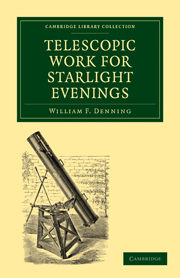Book contents
- Frontmatter
- PREFACE
- Contents
- ILLUSTRATIONS
- CHAPTER I THE TELESCOPE, ITS INVENTION AND THE DEVELOPMENT OF ITS POWERS
- CHAPTER II RELATIVE MERITS OF LARGE AND SMALL TELESCOPES
- CHAPTER III NOTES ON TELESCOPES AND THEIR ACCESSORIES
- CHAPTER IV NOTES ON TELESCOPIC WORK
- CHAPTER V THE SUN
- CHAPTER VI THE MOON
- CHAPTER VII MERCURY
- CHAPTER VIII VENUS
- CHAPTER IX MARS
- CHAPTER X THE PLANETOIDS
- CHAPTER XI JUPITER
- CHAPTER XII SATURN
- CHAPTER XIII URANUS AND NEPTUNE
- CHAPTER XIV COMETS AND COMET-SEEKING
- CHAPTER XV METEORS AND METEORIC OBSERVATIONS
- CHAPTER XVI THE STARS
- CHAPTER XVII NEBULÆ AND CLUSTERS OF STARS
- NOTES AND ADDITIONS
- INDEX
- Plate section
CHAPTER X - THE PLANETOIDS
Published online by Cambridge University Press: 05 July 2011
- Frontmatter
- PREFACE
- Contents
- ILLUSTRATIONS
- CHAPTER I THE TELESCOPE, ITS INVENTION AND THE DEVELOPMENT OF ITS POWERS
- CHAPTER II RELATIVE MERITS OF LARGE AND SMALL TELESCOPES
- CHAPTER III NOTES ON TELESCOPES AND THEIR ACCESSORIES
- CHAPTER IV NOTES ON TELESCOPIC WORK
- CHAPTER V THE SUN
- CHAPTER VI THE MOON
- CHAPTER VII MERCURY
- CHAPTER VIII VENUS
- CHAPTER IX MARS
- CHAPTER X THE PLANETOIDS
- CHAPTER XI JUPITER
- CHAPTER XII SATURN
- CHAPTER XIII URANUS AND NEPTUNE
- CHAPTER XIV COMETS AND COMET-SEEKING
- CHAPTER XV METEORS AND METEORIC OBSERVATIONS
- CHAPTER XVI THE STARS
- CHAPTER XVII NEBULÆ AND CLUSTERS OF STARS
- NOTES AND ADDITIONS
- INDEX
- Plate section
Summary
Number.—These bodies, also called minor planets, and, formerly, asteroids, comprise a very numerous class, and they are extremely small, being quite invisible to the naked eye except in one or two special cases. They all revolve in orbits situated between Mars and Jupiter. The total number discovered is about 300, of which Prof. J. Palisa of Vienna has found more than 70, and the late Dr. C. H. F. Peters of Clinton, N.Y., 49. I have not given exact numbers in the two former cases, because these discoveries are still rapidly progressing.
History of their Discovery.—The first known planetoid (Ceres) was sighted by Piazzi on Jan. 1, 1801. The following year, on March 28, Olbers found another (Pallas). In 1804, on Sept. 1, Harding discovered a third (Juno); and in 1807, March 29, Olbers was a second time successful (Vesta). Then for thirty-eight years no additions were made to the number. The host of planetoids circulating between Mars and Jupiter preserved their incognito without disturbance from the prying and wakeful eyes of astronomers.
But in 1845 Hencke, of Driessen, after years of watching, at length broke the spell of tranquillity by finding another small planet; and his example was emulated by many other observers in subsequent years. Hind, De Gasparis, and Goldschmidt were amongst the earliest and most successful of those who gathered new planets from amongst the stars of the zodiacal constellations.
- Type
- Chapter
- Information
- Telescopic Work for Starlight Evenings , pp. 167 - 169Publisher: Cambridge University PressPrint publication year: 2010First published in: 1891



